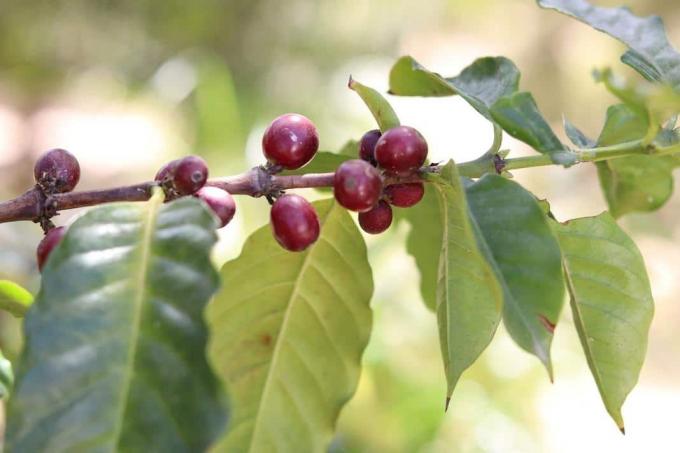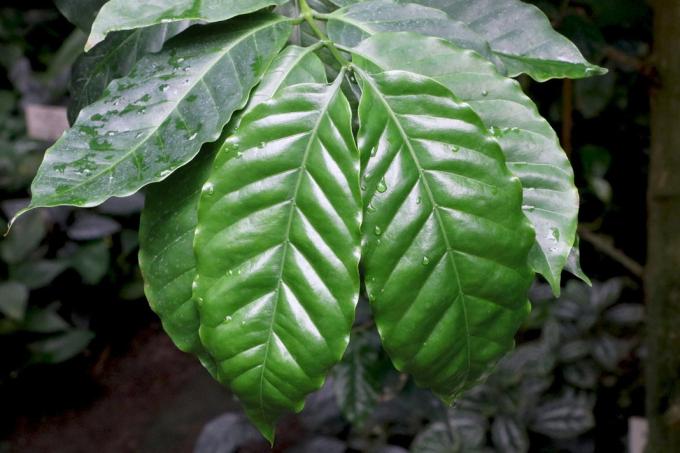
table of contents
- Brown leaves on the coffee
- Location-related factors
- Nursing-related factors
- Parasitic causes
- Prevention instead of fighting
Coffee is not only popular among gourmets, but also among hobby gardeners. Because the coffee plant impresses with its impressive appearance and gives every room a touch of exoticism. It happens again and again, however, that the plants get brown leaves. Find out here how the quick remedy can be achieved and how the coffee plant can be saved.
Brown leaves on the coffee
There are many causes of brown leaves on the coffee plant. However, all of them can be traced back to either the location, the care, or the parasites, so that research into the cause can be quickly narrowed down before the detailed search. These causes occur again and again, but can usually be easily eliminated with the measures described:
Note: The causes of brown foliage on Coffea Arabica cannot always be clearly assigned to a specific cause. This is due to the fact that different causes often cause each other or at least promote one another, so that ultimately a whole hodgepodge of causes leads to the brown leaves. However, it is often enough to eliminate just one of the causes in order to get the overall effects under control. For example, a drought-loving parasite does not have to be fought separately, as sooner or later it will run away if the air humidity increases.
Location-related factors
1. Too dark location
Coffee is considered a plant with a high need for light. An unchanged location is then often difficult, especially in winter, as the available brightness decreases with undiminished demand.
Possible remedy:
- Change location, e.g. B. choose a lighter location in winter
- Use of plant lighting during the dark season
2. sunburn
The coffee plants need a lot of light, but react to excessive radiation intensity with burns and leaves turning brown.
Possible remedy:
- Choose a sheltered location in summer, for example no pure southern exposure
- Alternatively, provide sun protection that allows light to pass through, but partially rejects direct radiation
3. Humidity too low
If the air is too dry, coffee leaves can also turn brown. This phenomenon is often associated with drafts, as moving air very effectively removes moisture and increases the drought. As a result, the leaves of the plant are attacked and react with dehydration and discoloration.
Possible remedy:
- wind or Choose a location that is more protected from drafts
- Increase the humidity of the location with additional evaporators, adjust maintenance measures if necessary
Nursing-related factors
1. Too moist soil or Waterlogging
If the soil around the roots of Coffea Arabica is too wet, mold and other impairments lead to damage and deterioration in the supply. The first signs of this are undersupplied leaves, which die off over time and turn from green to brown.
Possible remedy:
- Changed watering behavior, reduce watering, if necessary more often
- Improve the drainage performance of the substrate by adding sand
- Provide the flower pot with drainage openings to drain waterlogging
2. Inadequate supply of nutrients
If the coffee plant lacks nutrients such as nitrogen and minerals, it usually reacts to this by “switching off” the least needed components - the leaves. These first turn brown and then fall off.
Possible remedy:
- Adjustment of the fertilizer application, ideally regularly with the irrigation water
- Alternatively, e.g. B. In the context of repotting: Replacement of the leached substrate with new, pre-fertilized substrate with a high nutrient content
Parasitic causes
1. Aphid infestation
Aphids are hardly picky about their host plants, but nevertheless, or perhaps precisely because of this, they can be found again and again on coffee. Due to their diet through plant sap, they damage the infected leaf parts several times. The bite points allow other fungi and pathogens to easily penetrate the plant. The loss of the sap means a general weakening. And finally, the secretion excreted by aphids affects the metabolism on the leaf surface. Leaves that are so often disturbed show an increasing brown coloration with subsequent leaf loss.
Possible remedy:
- Use of chemical insecticides
- Use of home remedies, such as spraying on soft soap solution or Stinging nettle manure
- Favoring aphid predators such as ladybirds or parasitic wasps
tip: Nettle manure as well as ladybirds and parasitic wasps initially seem hardly feasible for a houseplant. However, these alternatives to chemical agents, which are usually also critical for humans, can be implemented well on the balcony or terrace. Positioned near the garden, the hoped-for beneficial insects often come by themselves in the warmer months to take advantage of the food available.
2. Spider mites
Spider mites are also not very picky. They are also often found on coffee plants and can also be easily identified by their webs. For the plant itself, they produce effects comparable to those caused by aphids. Because the spider mites also feed on the juice of the leaves and young shoots. Thus, the affected plants also react in the same way by turning brown and shedding infected components.
Possible remedy:
- Increase in humidity (see care measures), as spider mites prefer dryness
- Intensive rinsing of the plant with water, several times if necessary
Prevention instead of fighting
The sticking point in remedying brown leaves on the coffee plant is that the Action can only be taken after the symptoms have already taken the form of the unwanted discoloration appeared. Affected leaves can hardly be saved. It is therefore worthwhile to take preventive action from the outset and to prevent possible difficulties through targeted countermeasures:
- Examination of the location in terms of exposure, ventilation and humidity
- If necessary, change of location, for example to a lighter location in winter or to a less intensely lit place in summer
- To improve the air humidity, for example, place a saucer with clay granulate as a water reservoir, or give water less but more frequently
- Apply nutrients regularly with irrigation water
- Use insect screens against lice and other parasites






